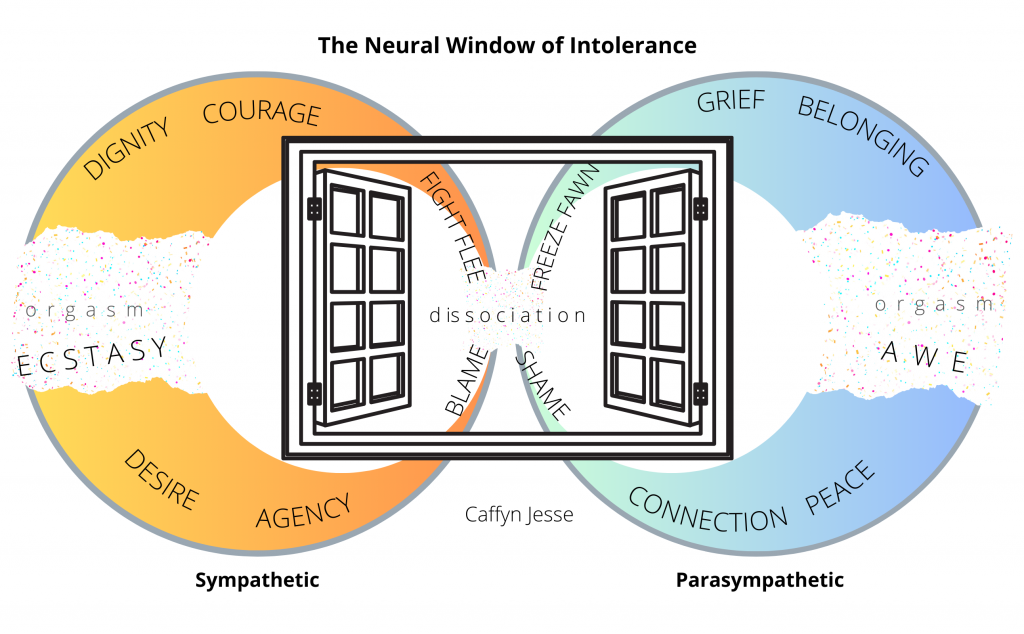Map Step 1 Step 2 Step 3 Step 4 Step 5 Step 6 Step 7
Step 1
Find Holding
The first step in a Generative Conflict process is to find someone to anchor us in belonging – to ourselves, to our own values, and to those we love. We can begin by understanding our neural “window of intolerance.”* When we are harmed or in danger, we come into a very intense part of our nervous systems, where we have limited options. The energies of fight, flight, appease, freeze and dissociate are available to manage threat. Our loud, persistent internal dialogue demands attention, with stories of shame or blame. We feel an urgent need to solve or escape the conflict.

If we engage in conflict from within our neural window of intolerance, there is no way it can be generative. We might make an angry complaint, and demand behavioural changes we think will make us stop hurting. We are likely to meet another’s blame, defensiveness and outrage, and then try to make that vanish. We might collapse our resistance with appeasement, or dominate another by mobilizing even louder outrage, better proof, and more people who think we are right and they are wrong. Step one in a process of generative conflict is recognizing stories of shame and blame as our soul’s cry for attachment. Shame and blame are ways we reach out from our neural window of intolerance to reconnect with ourselves and to recover belonging in community. We reach out without competence, and we need help.
Step 1 in our process of generative conflict is noticing when we are stuck in a neural window of intolerance. We need support. We need to find a resourced ally, to anchor and affirm our belonging, and hear our stories. We need help from someone who knows us and believes in us.
An ally is someone who can hear blame or shame as a cry for attachment. They know how to hold our stories, and hold us lovingly, through a process of listening to high-intensity complaints – without getting drawn into either fixing or denying the conflict. It is not their job to solve the problems, mobilize support, have opinions or give advice. They need to hold us and hear us in our woundedness and wonderfulness, without escalating the conflict. They affirm and anchor our belonging. They hear how much we hurt. They gently guide us to recuperate projections. They understand the impact of power dynamics and systemic oppressions, and help us see our stories in context. An hour of being held can often resource us to move out of our neural window of intolerance and into our window of tolerance. We can reconnect with who and how we want to be. Once we are outside of our neural window of intolerance, we have choices and capacity for social engagement.
Often the first story we share with an ally is blame. What did they do wrong, and how did it impact us? Go deep into the agony. The next story is often shame. Where did I fail them, and fail myself, and my integrity? What am I afraid of having done? What do they think of me? How does that trigger feelings of unworthiness and not belonging?
If our conflict is with someone we feel a relationship commitment with, if our ally agrees we are ready, and if the person we are in conflict with is similarly resourced, then we might choose to exit the conflict map at this stage. We can come back into a conversation, beginning with a courageous commitment to centered accountability, to our own souls, and to the relationship. Each person can offer an understanding of and apology for their part in the conflict, along with a willingness to learn, and share. When we engage in a conflict with capacity to inhabit all the parts of our nervous systems, we have capacity to hear the unintended impacts we have had on another. We can listen with discernment, still belonging to our values and the process. Remedies we co-create from this conversation are likely to go beyond superficial problem-solving and compliance. We can make more authentic change and lasting repair.
When we are stuck in a neural window of intolerance, we are not going to be able to engage in resourced conversations and become changemakers together. We need more help. One person might need help from an accountability support pod, to resource their understanding of power dynamics and systemic oppressions. Another person might need help from a therapist who can guide them to mature their attachment patterns. Another might need many more hours with an ally who can guide them through minefields of personal triggers activated by a conflict. Even when we feel fully resourced and capable, the person or institution we are in conflict with might be stuck in reactivity. When people can only threaten, and defend themselves with blame, or when they are collapsed in dissociation and appeasement, we cannot engage productively in generative conflict. A person might have an actively malevolent intent, a cultural incompetence, or a personality disorder. Assessing our own and the other’s capacity is an ongoing part of this process.
*Caffyn Jesse has engaged playfully and seriously with Dan Siegel’s “Window of Tolerance” – here is a video exploring more:
